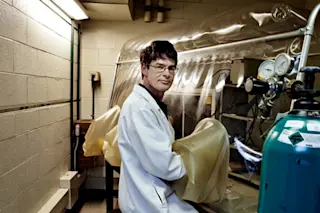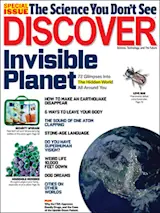The first time Tullis Onstott ventured underground, he squeezed into an elevator with dozens of South African gold miners and descended a mile into a pit called Mponeng. His goal: Finding the bizarre, hardy microbes that survive in sweltering, inhospitable rock. A geologist by training, Onstott spent his early career studying the Earth’s crust—until he heard a talk in 1993 about colonies of bacteria living thousands of feet below the surface. Ever since, he has made dozens of deep expeditions, sometimes paying his own way, and discovered bacteria living more than two miles beneath the surface in 140-degree-Fahrenheit heat. By investigating microbes in these harsh environments, Onstott is gleaning clues about how life could have begun in Earth’s hot, chaotic early days—and about what it might look like on other worlds. Even his office is underground, in the basement of Princeton University’s geology building, where Onstott met with DISCOVER reporter Valerie Ross.
The first time you went underground to look for life, in 1996, you had no idea what to expect. What was that trip like?The miners took me into the stopes, the tunnels where they mine gold, to sample the rocks. We were looking at an organic rock layer just millimeters thick that had lots of carbon, because we figured somewhere with a lot of carbon was a good place to look for life. The stopes are a meter high and they tilt downward at a steep angle, so you go down them almost like a slide, passing from one tunnel to the next. I basically slipped into a rabbit hole and got this big chunk of rock. I put it in an autoclave bag [normally used for sterilizing equipment], stuffed it in my knapsack, and then I went down the stope further until I came out the bottom into another, deeper tunnel.
What did you do with the sample you collected?We measured the rock’s radioactivity. The Geiger counter showed it was hot as a pistol, so we sealed it up in a steel canister and filled the canister with argon gas, which pushed out all the oxygen. Organisms that live deep down are not normally exposed to oxygen, and in fact it could be toxic to them. So we sealed the rock away until we could get it back into the lab. I checked this radioactive rock inside a steel thing as baggage on a plane. This was 1996. Airport security was not like it is today.
When you analyzed the sample back at your lab, did you find any life?We found one bacterium species similar to one previously identified from a hot spring in New Mexico. But the surprise was that this particular species could do something the other hot spring organisms could not: reduce [i.e., transfer electrons to] iron, which is present in minerals that are abundant in the mine’s rocks, and uranium, part of soluble compounds found in water in the mine. That helped us understand how they got their energy.
Then you found still more perplexing discoveries in other South African mines—for instance, microbes similar to those previously seen only at the bottom of the ocean.That’s right. We went back to South Africa in 1998, this time to Driefontein Mine, located about 40 miles southwest of Johannesburg, and took water samples, which are easier to work with than rock and less likely to be contaminated. We started finding the same organisms that people were reporting from deep-sea hydrothermal vents [where hot, mineral-laden fluid flows through volcanic rock into the ocean from deep within the Earth]. We don’t know how the same organisms got to be in both places, because South African crust has not seen ocean water in two-and-a-half billion years. It’s very much a mystery. We published the data, and the National Science Foundation gave us more money to go back again in 2000.
What happened on your third deep excursion in South Africa?The next time, we purchased a house in one of the villages near the gold mines and set up a semipermanent lab there. Over two years, a rotating team from my lab and six other institutions collected most of the samples that we’re still working on today. One thing we did was expand on our first find and look at more radioactive samples. We began developing an idea that radiation in the rock provides energy for microorganisms. Wherever we had radiation, we tended to see hydrogen gas forming. It made me realize that radiation should produce hydrogen by breaking water bonds. Hydrogen is the key component the bacteria need to make ATP, the molecule they use for energy.
One bacterium we found is entirely self- sufficient, a one-species ecosystem. Such things aren’t supposed to exist.”
That’s amazing, since we usually think of radioactivity as deadly—but these organisms were actually living on radiation?Well, not just radiation, but radiation, water, and rock were all that was needed to support life at depth. You don’t need light, food, or anything else from the surface. Plus, it’s a renewable energy source. It turns water into hydrogen and hydrogen peroxide, which helps make the metals that the organisms consume. It is like recharging an electric battery. The radiation keeps on recharging the battery for the bacteria that then do their thing. Those bacteria could then sustain other deep organisms. That finding was really important to NASA because you can imagine any body in the solar system that has liquid water beneath the surface—like Jupiter’s moon Europa, probably—will have energy for organisms as well.
Can we observe these organisms at work in the lab?The rule of thumb is that when you get back to the lab, you can grow less than 0.1 percent of what actually exists down there. We tried all sorts of ways to grow them, gave them all sorts of nutrients we thought they might want, and we failed miserably.
Since you couldn’t grow the bacteria that you found deep down, how did you learn just how they functioned?We looked at their DNA instead, which we filtered out of the water, to determine where these things fit in with other sorts of microbial life.

Tullis Onstott has to put on a headlamp and protective gear when excavating microbial live in some of South Africa's deepest mines. | Photo by Jess Dittmar
Organisms so far underground, reliant on so few resources, must live a pretty limited existence, right?Since the population of cells down there is small, most people thought they would just barely be able to eke out a living, that they were organisms with very few capabilities. But it turns out that was totally wrong. We did a full analysis of Candidatus Desulforudis audaxviator, an organism we found again and again in different mines in South Africa at the greatest depths—never above 2 kilometers (1.2 miles)—that made up 99.9 percent of the DNA in some of our samples. This thing had everything. It could take nitrogen directly from its environment, something we did not expect subsurface organisms to do because it takes so much energy. But the real surprise was that it had genes for flagella, tails bacteria use to propel themselves, which basically means it could be swimming around in the environment. It had genes for gas vesicles, which means it can adjust its buoyancy in the environment. And it had genes for chemoreception, which tells us it’s sensing something. The genome is saying it’s a very adaptable organism, and it has the capability of moving around. The idea that organisms down there might be moving around and interacting with the environment—that was really surprising. The only tip-off from the genome that this is a subsurface organism is that it has no protection against oxygen. As soon as it hits air, it’s dead.
And does that microbe interact with other species down deep?Candidatus Desulforudis audaxviator is entirely self-sufficient. It has its energy source, radiation. It contains everything it needs to exist, and it requires nothing from another organism. The fact that we’ve found it almost by itself tells us that it’s a one-species ecosystem. Such things aren’t supposed to exist. We thought all organisms depended on others, but this one doesn’t. We’ve found a whole new way to live.
In addition to bacteria you also discovered more complex, multicellular organisms living 1.5 kilometers down—almost a mile underground. What are they, and how did you find them?In 2006 I was contacted by Gaetan Borgonie, a Belgian scientist who had found microscopic roundworms, or nematodes, in caves in Central America. After he contacted me, I remembered seeing worms in biofilm, a goop made up of bacteria, in a mine in South Africa, too. So we went down together into the mines in South Africa to collect samples of biofilms. It turned out that the biofilms in the mines were just loaded with them. This nematode has about 1,000 cells, so it’s not exactly a big guy, but still—I never would have expected to find it so deep.
The deepest organisms you have found so far are from 3.8 kilometers (2.4 miles) underground—the farthest that it’s been possible to explore until now. How much deeper might life go?At Mponeng mine, a company is now drilling a tunnel to explore for gold five-and-a-half kilometers down. Gold prices are so high that for them, it’s economically feasible. For us, we think, “Yay!” The deeper, the hotter, the better. Down that far, it’ll be 90 degrees centigrade, about 195°F. That’s almost boiling. It’s a significant increase in depth, and we’re excited to see what the next several years will turn up.
What will going that deep into the planet tell us about life and evolution up here on the surface?We’re trying to see what the base of the biosphere, of all life on Earth, looks like. If DNA organisms exist down that far and at such high temperatures, we want to find them, and if they don’t, we want to understand why. And if there are no DNA organisms, are there other types of organisms that might occur there in very small concentrations? There may exist a shadow biology—very, very primitive organisms that may have come into existence very early on our planet but were completely replaced by DNA organisms everywhere else.
So far you’ve talked only about hot environments, but what about the other extreme? Many of the places elsewhere in the solar system where we’re looking for life, like Mars, are intensely cold. Have you explored any analogous low-temperature environments on Earth?Mars has this very thick cryosphere, or permanently frozen rock layer, on its surface. So we went to a gold mine deep beneath the permafrost in the high Arctic, in the Nunavut territory in Canada. The mine has a helical tunnel that goes a kilometer and a half down. All this warm air comes up from below, and as soon as it hits the permafrost layer, where the ground is permanently frozen, all the moisture in the air crystallizes and you get huge snowflakes, a couple of feet wide. You get ice stalactites and ice stalagmites all over. It looks like Superman’s sanctuary. It’s easy to imagine there might be something like this on Mars as well. I had an epiphany within these ice caves: This is the kind of environment you’d want to explore if you ever went to Mars; send your rover inside the caves and have a look around. There’s moisture there. There’s plenty of room for life in these environments. Unfortunately, we never really had a chance to explore and look for life in those caves before that mine shut down.
Could we pick out signs of microbial life on Mars even before we go digging around in caves there?On parts of Mars, there’s methane gas that may be seasonal. It seems to appear and then go away. That means something unusual is happening: There has to be something that makes the methane and something that consumes it. The question is, are life-forms making and consuming the methane? If life is generating and consuming that methane, its chemical signature will change because of those biological processes. So as a project with NASA, we’re developing an instrument that we hope will fly to Mars and measure the composition of the methane gas. If we find that it is going through a seasonal cycle and its composition is changing, that’s a very good indication that there’s something alive on Mars. But whatever that something is, it’s going to be something quite different from anything we’ve seen on Earth because the surface conditions on Mars are pretty inhospitable to life as we know it.
You’ve looked at other extremely cold environments to learn more about life here on Earth, too. What was that like? We’ve gone up to Axel Heiberg Island, a Canadian island high in the Arctic Ocean, to do some work there at the McGill Arctic Research Station, a.k.a. Mars. It’s one of the largest uninhabited islands in the world, and very beautiful. It has enormous mountain glaciers, almost like a little Swiss Alps, so it’s a nice change from the mines. We went up there to study microbes living in the permafrost that have been frozen for millennia.
The Arctic regions where those microbes live are warming rapidly. What impact might that have on the Earth? There’s a concern that those microorganisms will all of a sudden kick on and start chewing up organic matter, making carbon dioxide and methane. That could cause a runaway greenhouse effect in the later part of the century. Our mission is to try and understand whether that will happen. We collected 40 ice cores from the island. We’re gradually thawing them to study which microorganisms are doing what, and which gases are being released and how quickly. Then we’re comparing this to field measurements that we can make in the Arctic, to see if the environment seems to be doing the same things as the permafrost in the lab. A lot of groups are doing similar studies across the Arctic. We don’t know the answer yet, but what we all find should further our understanding of what to expect over the next 100 years.
Has studying these various kinds of extreme, deep-dwelling microbes changed your thinking about what’s necessary for life? The more I learn, the more it seems that the requirements for life are pretty minimal. The niches that life can occupy never cease to amaze me. A place may look terrible to us, but to something else, that’s their Eden.
OTHER SUBTERRANEAN HABITATS
While Onstott searches for microbes in gold mines and permafrost, other researchers are seeking out life in other deep locations. Their results are filling the picture of Earth’s buried ecosystem.v. r.
1 Around Hydrothermal Vents The scalding hot, sulfur-laden waters of hydrothermal vents, where ocean water heated by magma reemerges through cracks in the seafloor, are teeming with microscopic life. These bacteria support complex ecosystems in dark, otherwise sparsely populated ocean depths. Oxford zoologist Alex Rogers and his team explored the life around a 720°F vent off the East Scotia Ridge near Antarctica (shown here). In January they reported a host of unusual animals living near the vent, including a seven-armed sea star, a “ghostly white” octopus, and a new species of yeti crab, its underside covered in hairs.
2 Under the Ocean Floor Several teams are currently hunting for life beneath the seabed. Earlier this year, geomicrobiologist Katrina Edwards of the University of Southern California and her colleagues drilled into the crust of the Atlantic Ocean and installed small subsurface observatories to monitor microbial life. In 2010 scientists from Oregon State and other institutions drilled into the gabbroic layer—the deepest layer of the oceanic crust, close to the hot, mineral-rich mantle—to find a host of bacterial species capable of gobbling up hydrocarbons from an unknown source.
3 In the Deepest Caves The world’s deepest known cave, Krubera-Voronja in the Republic of Georgia, extends down a mile and a quarter. Biologist Ana Sofia Reboleira of the University of Aveiro in Portugal, who has been exploring caves since she was a teenager, recently searched Krubera-Voronja for the rare, small organisms that populate it—a cold business, since temperatures in the pitch-black depths hover just above freezing. This year, she and her team reported four new species of eyeless, wingless insects at various depths, ranging from 60 meters to almost 2,000 meters (more than a mile), near the cave’s bottom.
MAPPING DEEP LIFE WITH DNA
Onstott calls his trips into the gold mines “underground safaris,” but finding new species in the depths of the Earth is a far cry from spotting them on the savannah. The only species Onstott has observed in action are nematode worms; he could see them squirming under a microscope, and took detailed electron microscopy images of their hundredth-of-an-inch-long bodies. He also found cells of D. audaxviator, a bacterium that made up 99.9% of the organisms he recovered from one of the filters used to extract water from rock fractures deep in the mines. Onstott imaged what he could of those cells with a transmission electron microscope. But he has never been able to see any bacteria moving around, or grow them in the lab. Instead, the vast majority of what he studies is DNA traces. D. audaxviator provided enough genetic material to yield that species’ whole genome, allowing Onstott to ascertain that the organism belonged to a self-sustaining ecosystem and could sense its environment. In other cases he has found bits of free-floating genetic material from other species—just enough, he says, to show that each one exists deep in the mines and is largely specific to the fracture in which it was found. “As you move from one fracture to the next,” Onstott notes, “the microbial species change.”















